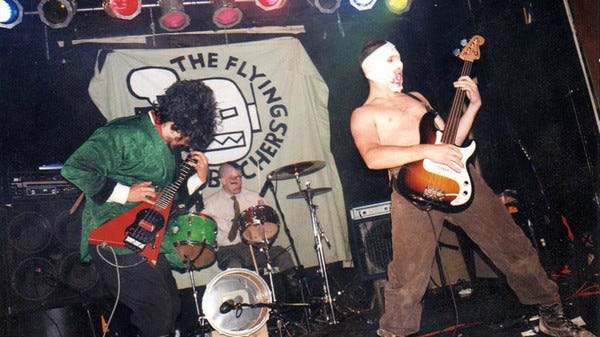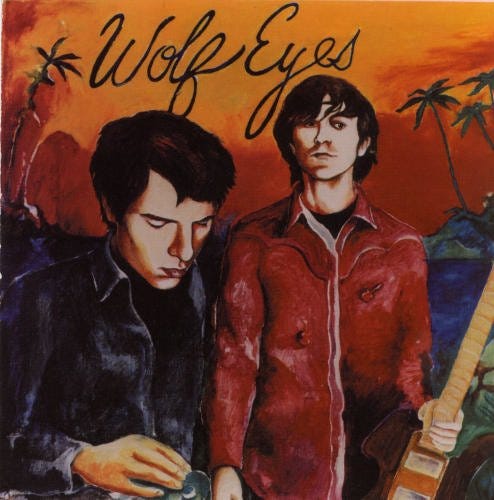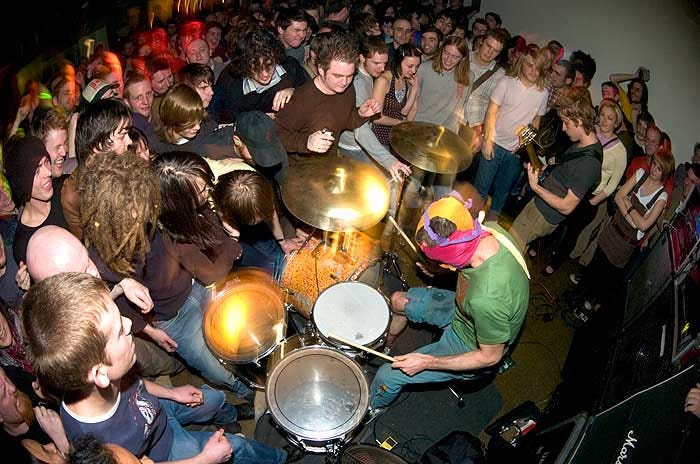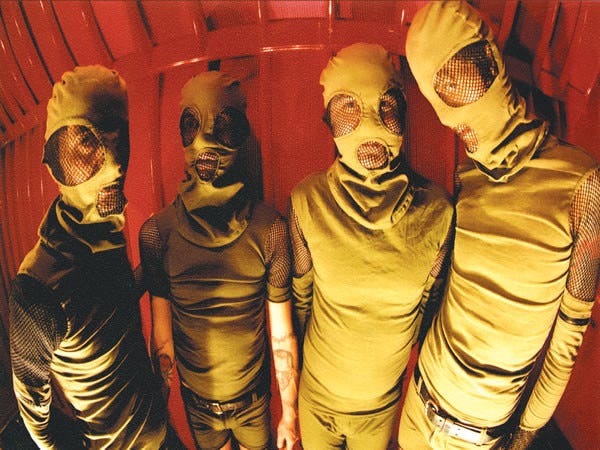Sunday, July 14, 2002
Detroit, Michigan
“You gotta see em live” always sounded like a hollow phrase, a way to demand someone appreciate the same music you do. If a song doesn’t move you from shitty car speakers, how could the same thing in person be any different?
I went to college in Bowling Green, Ohio, which is about 30 minutes from Toledo and about an hour from Ann Arbor and Detroit, where you can see the actual Hotel Yorba from 75 as you enter the city. I’d usually catch a ride with my friend JR to shows at the Magic Stick and C-Pop Gallery in the Motor City, but on this July weekend our driver was Jason Zeh, piloting his parent’s minivan.
Skin Graft records organized Oops! in 1994 as a semi-regular festival type event at Chicago’s legendary Lounge Ax venue, whose fertile post-rock, noise, etc scene made such an event popular. After touring sporadically as a multi-media event (with a theater troupe providing between-band skits), the 2002 edition was a cooperation with Load Records, who had grown into a cornerstone of the new skuzzy psychedelic noise coming out of its home state of Rhode Island.
I had been to shows at the (possible defunct) Magic Stick many times in the past, but always in the evening. Oops! The Tour had an early door to accommodate the long lineup, so the sun was not quite set as we rolled up. As we walked up the long flight of stairs to the show room, I saw something that went unnoticed up until then: The Magic Stick had a window. It was up where the wall met the ceiling, but the light pouring in really opened up the dank gray space, still permeated with the smell of years of cigarette smoke despite the recent indoor ban.
I believe The Flying Luttenbachers were playing when we walked in. The crowd was a little thin since it was early, but the drums/two bass Infection & Decline lineup of the jazz/noise/metal/etc group were playing like they had a gun to their heads. Drummer Weasel Walter was in his Skinhead Mutant phase, with a shaved head save for 2 locks of hair gelled up into devil horns (or maybe it was a mohawk?). One of the bassists was shirtless & wearing what I thought was a hockey mask, though images from the era prove it was fabric wrapped around his face. The other bassist had on this quasi-pirate costume probably cobbled together from thrift stores. The songs all ran into each other without any pauses or stage banter, except at one point the Pirate Bassist needed a second to adjust something and yelled “WAIT!” at his bandmates in the brief silence before the next song.
The Flying Luttenbacher’s 1996 album Revenge had made a Best Of list in an issue of Guitar World, so I was at least a little bit familiar with them. Their most recent album at the time got some decent airplay on my university’s radio station, but it just seemed like noisy jazz to me. In person, it was like shards of glass from three different broken mirrors that somehow fit together perfectly. There was virtuoso skill on display, but in the service of something other than showing off how good they were. To be honest it was a bit more than my brain could handle, but I was intrigued.
JR had played the self-titled Wolf Eyes CD in the car during trips to Ann Arbor, but my first reaction was What is this shit? It was just static! Was his stereo broken? He assured it me it was quality stuff, but I wasn’t sure. Live, the band was a full on punk rock explosion, with John Olson drenching the front row (including me) with beer during the first song. He had a suitcase full of oscillators open in front of him, Nate Young was moaning in a mic while adjusting a small modular synth setup, and Aaron Dilloway had a whole table of gadgets in front of him, along with a heavily modified guitar, and a contact mic in his mouth. The band lurched back and forth in a seasick sway, conjuring Dread and violence from their primitive setup. This wasn’t the kind of experimental music concert where you sat down and nodded in agreement to academic drones, this was a visceral show, with all the energy of a hardcore band. The frequencies started to re-arrange my DNA, and suddenly Wolf Eyes (and noise music in general) started to Make Sense.
Arab on Radar had a very strict onstage setup: 4 guys in matching Dickie’s outfits, lit by a row of harsh lamps they set up at the foot of the stage, facing back at them. The two guitar/bass/drums/vocals setup was the first quasi-standard Rock Band arrangement of the night, and in their own weird way they were the most straightforward band on the bill. They had a reputation as a No Wave noise band, but the serrated guitars and squirming vocals came off more like a mutant hardcore band than the art school derelicts of 1970s NYC. The drummer counted off each song in a high, squeaking voice, then the guitarists churned out dissonant repetitive riffs while the singer yelped about bodily functions over top.
The sound seemed to push each band member around like they were trapped in a viscous fluid: one jumped in place, another spun around in tight circles, another balanced on the lip of the stage, his guitar thrust out from his crotch in a mockery of Cock Rock moves. Then, and now, I admire it when bands take a typical instrument lineup and do something completely different with them. Arab on Radar did that, and I was equally entranced and confused, especially when the guitar players took a few moments between each song to tune what sounded like out-of-tune guitars.
Lightning Bolt used to play on the floor. That was their Thing for a long time, that and playing in front of a wall of amps, and the drummer/singer wearing a mask and pummeling his kit while the audience lurched around him. I was, at the time, completely unaware of this feature of their live show, which is why I was at the front of the stage as they started playing at the other end of the venue.
Diehards knew the routine, so while half of us were stuck back behind the sea of moshers, others were in the splash zone of Brian Chippendale’s drumsticks. When I say it was a sea of people, that is no hyperbole: it was a huge undifferentiated mass of arms and legs, barely holding together as the group lost their balance, regained it, then nearly toppled over again. Their album Ride the Skies was played a lot of college parties I went to, so I knew the music, but it would be another couple years before I saw Lightning Bolt properly. By properly I mean, in a sketchy unmarked warehouse in Detroit, nearly getting decapitated by the cymbal when the crowd pushed forward. Lightning Bolt plays on stages now.
The Locust had a reputation in 2002, of being annoying hipsters, skinny Romulans with coke habits who could distribute Scene Points as they saw fit. After reading Justin Pearson’s book, it’s clear that reputation was projected on the San Diego band and had little basis in reality. The “coke mirror” merch that was so talked about back in those pre-Facebook message board days were really a box of blank promo makeup compacts one of the band members found, which was the perfect size and shape to affix their already-made band stickers. They were an easy target for the insecure to blame for something new infiltrating their hermetically sealed Scene, which is where the reputation became reality: They really hated the hardcore scene, and were willing to go to absurd lengths to try something, anything, to make it interesting. Weird stage clothes, adding a keyboard player, having songs that usually hovered around the 30 second mark, anything. They were trying to destroy music and build it up into something new, much to the chagrin of audiences expecting more chugga-chugga Victory Records hardcore.
This was their Bug Suit era, where each member wore matching nylon costumes with mesh masks. The second Lightning Bolt was done playing, The Locust launched into their first song, and the crowd from the other end of the floor surged forward towards us near the stage. You just had to kind of go with the flow, since any escape was blocked by people, the stage, or the mosh pit that had opened up behind us. Each song blurred into the next, punctuated with some snappy crowd work. Their songs all mostly sounded the same, so a request for “Dog Without A Collar (Run Over Red Rover)” would be quickly answered with “we already played that one” before launching into the next song.
After that show, the noisy, chaotic, and abstract music I didn’t understand suddenly made sense. It was most likely the way it used the same energy in punk rock and hardcore for artier, weirder ends. This was a lineup of bands trying to make music that no one had heard before, to push the limits of what was physically possible, and what people would stand to listen to. The fact that I was in a good venue with likeminded people also helped; the atmosphere was chaotic but fun. After that, a whole new world of music opened up for me, and for that I’m grateful. Maybe you do gotta see em live, maaaaan.





No comments:
Post a Comment